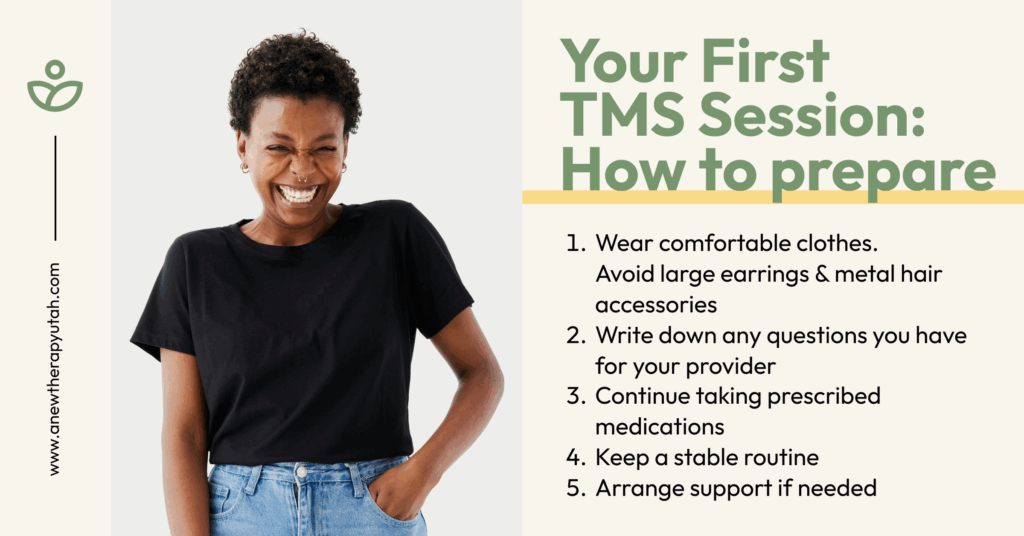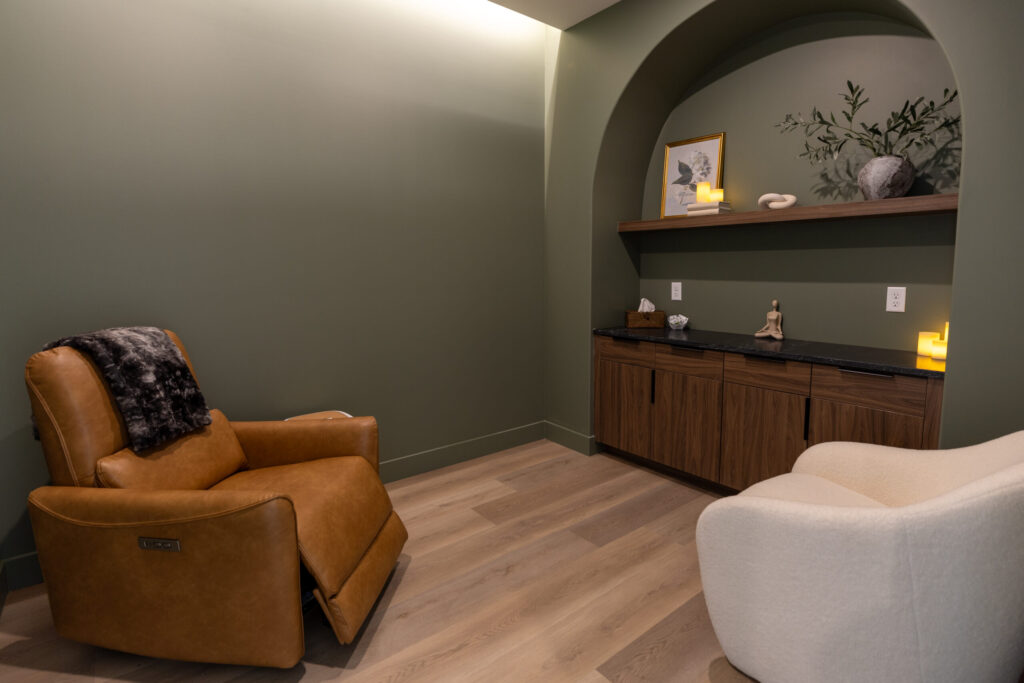If you’re preparing to begin TMS therapy, first of all, congratulations on taking a powerful step toward healing. Starting a new treatment for depression or OCD—especially one you may not have heard much about—can feel intimidating. Here at Anew Therapy, we’re dedicated to making your journey as smooth, comfortable, and transformative as possible. Whether you’re still exploring the process or your first appointment is already on the calendar, this guide offers practical tips and supportive insights to help you feel ready—physically, emotionally, and mentally—for the transformative experience of TMS therapy.
What Is TMS Therapy?
TMS (Transcramial Magnetic Stimulation) is an FDA-approved, non-invasive brain stimulation therapy that uses magnetic pulses—similar ins strength to those used in MRI machines—to activate specific regions of the brain associated with mental health conditions.
TMS is most commonly known for treating major depressive disorder by targeting the prefrontal cortex, a region involved in mood regulation. However, specialized TMS protocols, such as those using a Deep TMS H7 coil, are also FDA-approved for the treatment of Obsessive-Compulsive Disorder (OCD). These protocols focus on different brain regions—specifically the anterior dorsomedial prefrontal cortex (dmPFC) and the anterior cingulate cortex (ACC)—which are associated with the repetitive thought patterns and behaviors characteristic of OCD.
Unlike medication, TMS does not circulate through the bloodstream and typically results in fewer systemic side effects. For individuals who haven’t found relief through traditional treatments, TMS offers a safe, targeted, and often life-changing option for care.
Is TMS Right for You?
Before beginning treatment, you’ll undergo a thorough evaluation with one of our experienced providers to determine whether TMS is a good fit for your unique mental health needs. During this consultation, we’ll review:
- Your full medical and psychiatric history
- Current medications
- Past experiences with therapy and/or antidepressants
- Any other mental or physical health conditions
If you’re a candidate, we’ll also walk you through the process in detail and answer any questions you may have. If not, we’ll work with you to explore other treatment options, including Spravato or IM ketamine therapy.
Understanding the Commitment
One of the most important aspects of preparing for TMS therapy is understanding the time commitment. Here’s what you can expect:
- Each session lasts around 20-30 minutes (no downtime necessary)
- You’ll have 4-5 sessions per week
- Standard treatment course is 8 weeks
Because the treatment is cumulative, consistency is key to getting the best results. Our team will work with your schedule to make sure appointments are manageable and support your routine, but it’s helpful to plan ahead and build TMS into your daily life for the duration of the treatment cycle.
How to Prepare for Your First TMS Session
Here are some practical ways to get ready for your first TMS appointment:
1. Dress Comfortably
- Wear comfortable clothing and avoid wearing hats, large earrings, or any metal hair accessories, as the magnetic coil will be placed near your head.
2. Bring a List of Questions
- We encourage open communication at every step. If you have any lingering concerns or questions—such as how you’ll feel after treatment or how it might affect your sleep—bring them up with your provider.
3. Stay Consistent With Medications
- Unless your doctor advises otherwise, continue taking your prescribed medications. TMS is often used alongside antidepressants or mood stabilizers, and there’s no need to stop unless directed.
4. Have a Routine in Place
- Since TMS appointments occur daily during the week, having a stable routine can help support your mental health and make room for the treatment in your schedule.
5. Arrange Support If Needed
- Most people are fine to drive themselves to and from treatment, but during your first week, you may prefer to arrange a ride or have someone check in with you until you know how you’ll respond to the sessions.

What Happens During a TMS Session?
The first session includes a “mapping” process where your provider identifies the exact placement on your scalp to stimulate the right area of the brain. Once this is established, treatment sessions become straightforward and consistent.
Here’s what you can expect:
- You’ll sit in a comfortable, reclining chair.
- A magnetic coil will be gently placed against your scalp.
- You may hear clicking sounds and feel a tapping sensation, which can be strange at first but is generally well-tolerated.
- You’ll remain awake and alert the entire time.
There’s no need for anesthesia or recovery time, and most people are able to return to work or daily activities right after their appointment.
Possible Side Effects
TMS is generally very well tolerated, but like any treatment, it can come with mild side effects. Common ones include:
- Scalp discomfort or sensitivity
- Mild headaches
- Light fatigue or drowsiness
These symptoms often fade after the first few sessions, and our providers are here to help adjust your treatment settings if needed. Serious side effects are rare but will be discussed during your consultation.
Tips for a Successful TMS Experience
- Stick to the Schedule: TMS is most effective when treatments are done consistently. We’ll help you stay on track.
- Track Your Mood: Keeping a daily journal of your mood, energy levels, and sleep can help you notice subtle improvements over time.
- Stay in Touch With Your Provider: Your experience matters. Let us know how you’re feeling physically and emotionally during your treatment period so we can provide additional support or make adjustments.
Practice Self-Care: Getting regular sleep, eating balanced meals, and staying active can enhance the benefits of TMS.

When Will You Start to Feel Better?
TMS doesn’t work overnight, but many patients start noticing improvements after the first 2–3 weeks. For others, it may take a bit longer. That’s why sticking with the full treatment plan is so important.
You might notice:
- A lifting of the emotional “fog”
- Increased motivation or energy
- Better sleep or concentration
- Reduced feelings of hopelessness or anxiety
These gains may be gradual, but they add up—many patients report life-changing improvements by the end of the full treatment course.
After Treatment: What Comes Next?
Once your initial round of TMS is complete, we’ll schedule follow-up appointments to assess your progress and discuss next steps. Some patients benefit from periodic “maintenance” sessions, while others find lasting relief with just one course.
We’ll continue to work with you to ensure your long-term mental health is supported through therapy, medication (if needed), or other holistic options.
We’re Here to Support You Every Step of the Way
Your TMS treatment at Anew Therapy is a journey toward healing, and our team is here to support you before, during, and after your sessions. You’ll receive a follow-up message within 72 hours of your initial treatment to check in on your progress. If you have any questions or concerns, don’t hesitate to reach out.
Preparing for TMS therapy is more than just following steps — it’s about creating an environment of support, self-compassion, and readiness for the healing journey ahead. We look forward to walking this path with you and are honored to be part of your healing process.

Searching for the best TMS clinic in Utah? Anew Therapy offers expert care and proven results. Schedule your free evaluation today.

